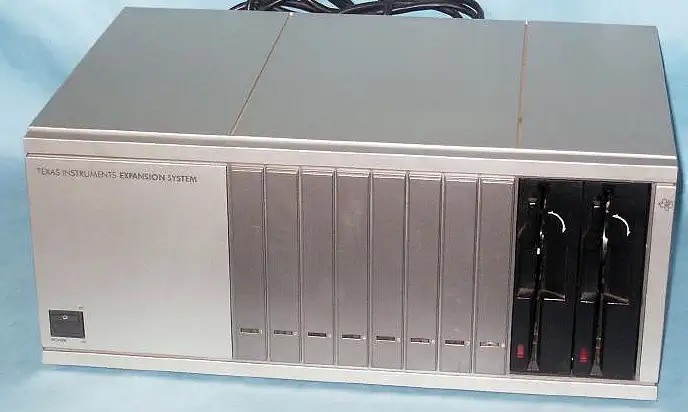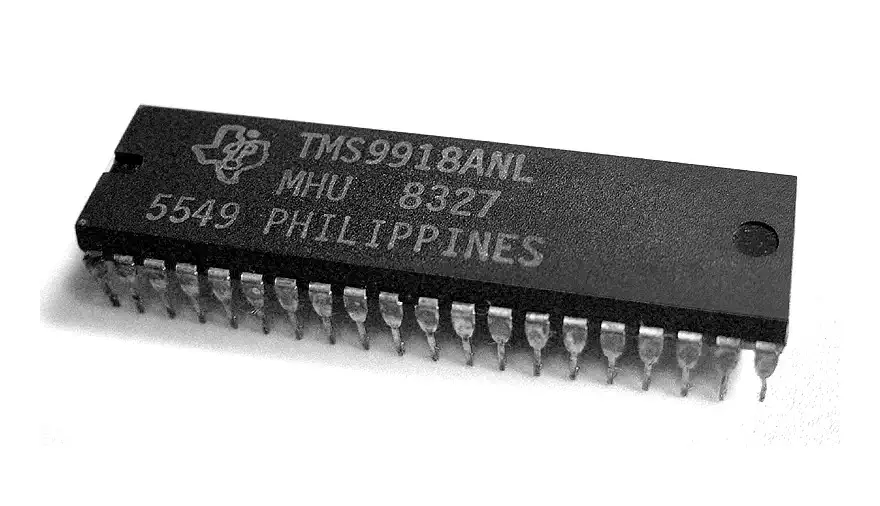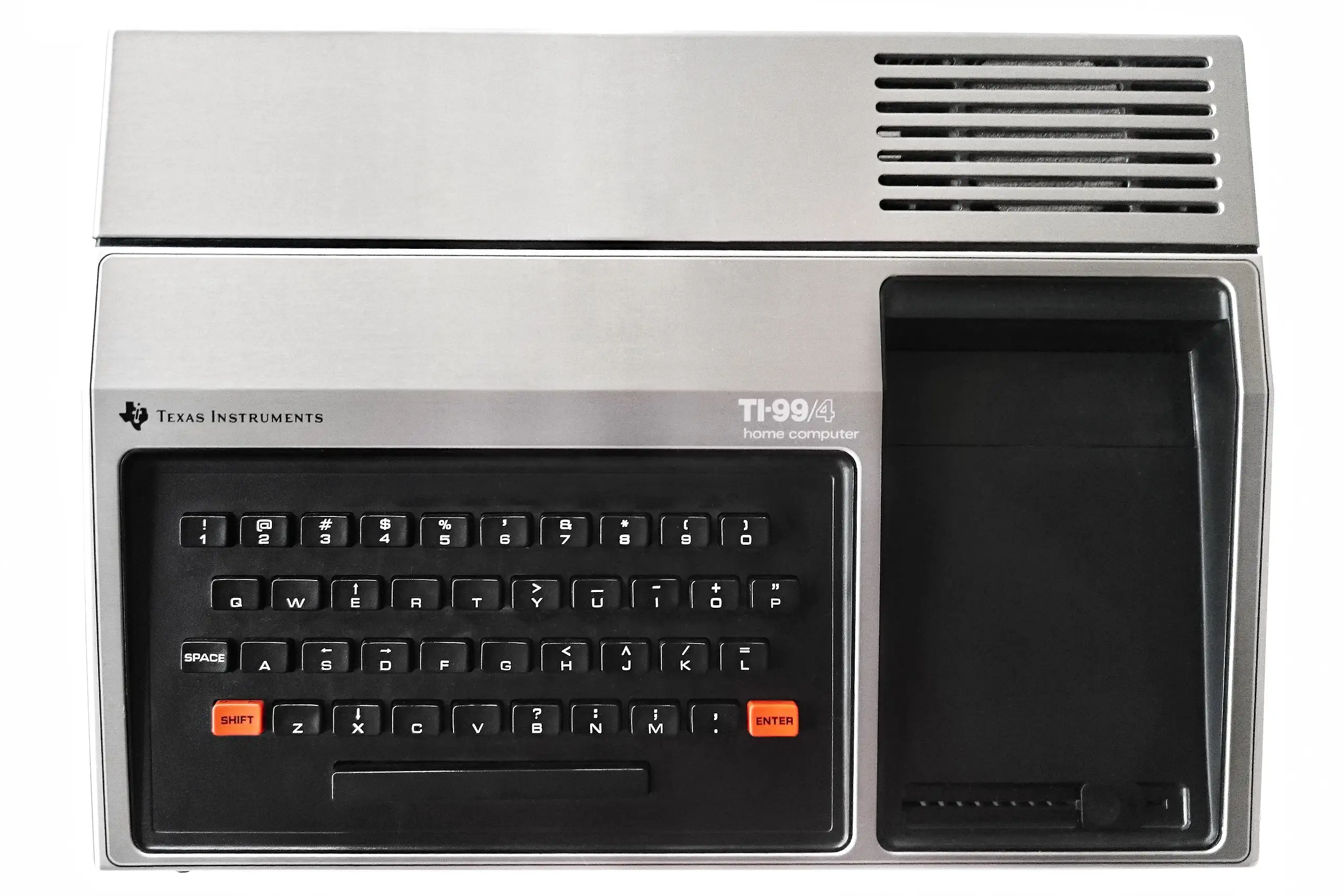Texas Instruments TI-99/4, the 16-bit Computer without memory
The Texas Instruments TI-99/4 was released in 1979. It ran on the TMS9900 microprocessor, a 16-bit processor. The machine had an advanced TMS9919 Video Display Processor that could produce 256x192 pixels in 16 colors and was capable of hardware sprites. This same chip is used in the MSX1 line of computers
The computer had a calculator style keyboard that made typing on it hard. One of the unique features of the system was the expansion system. Texas Instruments produced a Peripheral Expansion System box to contain hardware add-ons. Despite the advanced nature of the hardware, Texas Instruments insisted on remaining the sole publisher of software, which caused developers to focus on the competing systems such as Atari and Commodore.
Another problem with the system is that the RAM was shared with the VDP. To run the full screen capabilities with sprites and 16 colors, the VDP needs 16KByte of memory. But that is all the computer has. It does have 256 bytes of scratch pad RAM, which has the same role as registers in other CPU architectures. So when loading a BASIC program, not all of the features of the video chip could be used due to lack of memory. Memory expansion units were for sale driving up cost for the user.

TMS9918 Series Video Display Processor (99n8, 99n9, 91n8, 91n9)
The TMS9918 is a series of video display controllers (VDC) manufactured in 1979 by Texas Instruments, also refered to as 'Video Display Processor' (VDP). The TMS9918 and its variants were used in the ColecoVision, CreatiVision, Memotech MTX, MSX, NABU Personal Computer, SG-1000/SC-3000, Spectravideo SV-318, Spectravideo SV-328, Sord M5, Tatung Einstein, Texas Instruments TI-99/4, Casio PV-2000, Coleco Adam, Hanimex Pencil II, and Tomy Tutor.
Key Features:
- 256x192 pattern based color pixels per screen
- 16 different colors
- 8-bit memory mapped CPU interface
- No need for DMA, CPU can access VRAM
- 32 single color Sprites per screen (4 per scanline)
Variants:
- TMS9918A - 60Hz output, NTSC video
- TMS9928A - 60Hz output, YPbPr video
- TMS9929A - 50Hz output, YPbPr video
- TMS9118 - Different RAM than TMS9918A, otherwise identical
- TMS9128 - Different RAM than TMS9928A, otherwise identical
- TMS9129 - Different RAM than TMS9929A, otherwise identical

CPU View - Texas Instruments TMS9900 16-bit
The TMS9900 CPU, developed by Texas Instruments in 1976, is known for being one of the first 16-bit microprocessors available on the market, marking a significant leap forward from the 8-bit processors that were standard at the time. It was originally designed to power Texas Instruments’ own line of minicomputers, but it later found its way into other applications, most notably the TI-99/4A home computer, which was one of the first consumer-grade computers to feature a 16-bit processor.
Some key technical aspects and unique features of the TMS9900:
Architecture
The TMS9900 was based on the TI 990 minicomputer architecture and is fully 16-bit, including a 16-bit data bus and a 16-bit address bus, which allowed it to address up to 64 KB of memory. Its architecture is distinctive because it lacks an internal register set; instead, it relies on external memory-mapped registers, which means the processor operates directly on memory-resident data. This design provided some flexibility but also added overhead, as it depended heavily on memory speed and availability.General Purpose Registers
The TMS9900 had a unique setup where it did not have conventional internal registers. Instead, it used a “workspace†concept, where a block of 16 consecutive memory locations in RAM functioned as general-purpose registers. This workspace could be easily swapped by changing the workspace pointer, which was useful for multitasking and interrupt handling, as it allowed quick context switching by simply switching the pointer to a different set of registers in memory.Performance and Applications
While the TMS9900 was ahead of its time as a 16-bit processor, its reliance on external memory access for registers created bottlenecks. This was one reason why it didn’t see as widespread adoption as other processors of the era. In the TI-99/4A, Texas Instruments paired it with an 8-bit data path to reduce costs, which ultimately limited the TMS9900’s performance and left it underutilized in that system. However, the TMS9900 was also used in some industrial and military applications due to its robust instruction set and multitasking potential, especially before more advanced 16-bit processors like the Intel 8086 became mainstream.
Overall, the TMS9900 is a fascinating processor because it was pioneering in its 16-bit architecture and unique memory-mapped register approach. However, due to cost-cutting limitations and architectural trade-offs, it didn’t reach the widespread usage or influence seen by its contemporaries, but it remains an important milestone in early microprocessor history.
VRAM: 16kB Sound Chip TMS9919, later models used SN94624 Sound 3 voices, 1 white/periodic noise Display Chip TMS9919, later models used SN94624 Display 40x24 text
32x24 16 color text, pattern based
256x192 16 color, 2 color per 8 pix. Best Text 40x24 Best Color 16 colors (2 per 8 pixels) Graphics 256x192 in 16 colors Sprites 1 color, 16x16, 4/scanline, 32 total Original Price $1150

